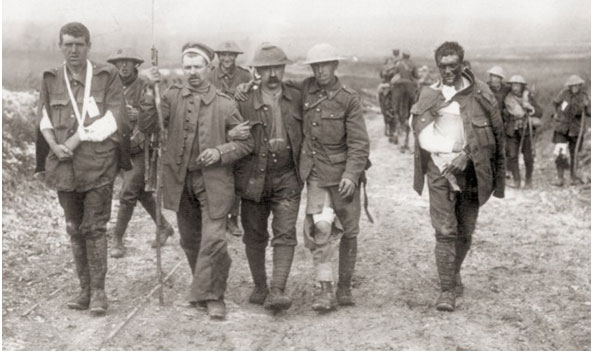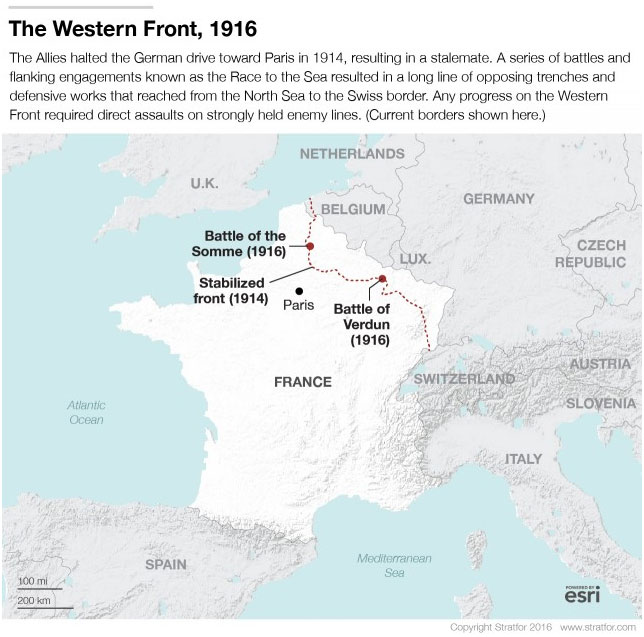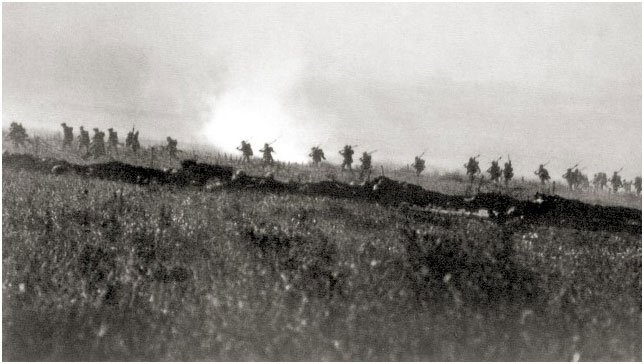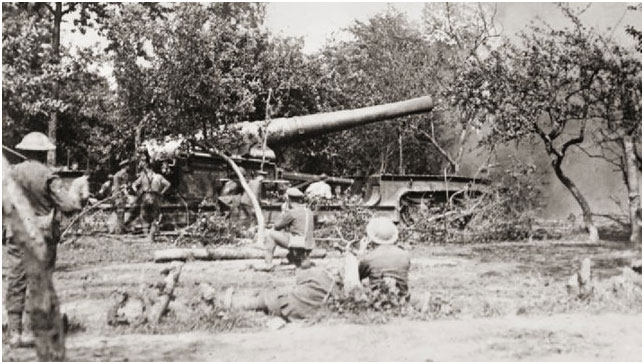Análisis Stratfor Global Intelligence, 09.07.2016

A German prisoner and British soldiers wounded in the Battle of the Somme make their way to a dressing station near Bernafay Wood following fighting on Bazentin Ridge, 19 July 1916. (Imperial War Museum)
Summary
A tranquil river basin in northern France will forever be associated with some of the most vicious and costly fighting of World War I. The terrain around the Somme River provided the battleground for a confrontation between elements of the German army and an Allied force spearheaded by the French and British. At the beginning of 1916, the Western Front was locked in a stalemate, blocked by the opposing battlements running from the North Sea to the Swiss border. The Allies sought to break the German defenses and to relieve pressure on the French at Verdun, wearing down the Germans in preparation for a decisive victory expected in 1917. It was hoped the July 1 Somme offensive would provide that break, and set the stage for the closing acts of the war.
While the French achieved some success on the opening day of the attack, the British Fourth Army suffered staggering losses — the worst ever in a single day of combat for the United Kingdom. Claiming around 60,000 British casualties, including almost 20,000 fatalities, the Battle of the Somme left an indelible mark on the psyche of a nation, no less diminished a century after the fact. By the offensive's conclusion on Nov. 18, 1916, over a million were dead or wounded. Yet for all its appalling losses, the armies and men who fought to the end of that particular battle ushered in new attitudes and approaches to warfare.
Analysis
The impetus for the Somme offensive came from the second Allied military planning conference at Chantilly, early in December 1915. The French army had expected to play a leading role in the battle, but its travails at Verdun significantly reduced the amount of forces the French army commander, Gen. Joseph Joffre, could commit. Fixed by the Germans in the hills north of Verdun-sur-Meuse, the beleaguered French could only send five divisions to the Somme and requested that the timeline be lengthened to ease their position. Dramatically, Joffre snapped that the French army would cease to exist should Commander-in-Chief of the British Expeditionary Force Douglas Haig wait until August to begin the assault, as initially planned. The paucity of the French meant that instead of having a supporting role, the British would have to spearhead the main effort, initially with 14 divisions. But even with a total of 19 divisions against Germany's seven, the Allied force still lacked the classic attack ratio of three-to-one. And the Germans were well prepared.

To set the conditions for the offensive and weaken the enemy's resolve, Haig's strategy relied on a weeklong artillery bombardment that would break the Germans' spirits, cut through their fortifications and limit their ability to fight back. Then it was anticipated that the Allied forces could roll through multiple breaches and overwhelm the German defenders, winning a decisive victory along the Somme River sector and easing the pressure on Verdun. Nothing about the battle plan was revolutionary; even the weight and duration of artillery was simply an extension of accepted tactics. Tried and tested schemes had repeatedly failed to break through the German lines, but Haig pinned his hopes for success on the concentration of force, using heavier and more sustained firepower to succeed where previous offensives had failed. Simply put, he scaled up firepower to match his opponent's defensive networks. This was to be the epitome of a set-piece battle, with different arms coordinating around but not directly supporting one another.
In contrast to the Allies, who sought to (in Haig's own words) "wear down" the enemy as a prelude to achieving a decisive victory, the Germans elected to maintain a doctrine of unyielding defense through 1916. In line with this strategy, the German defensive lines along the length of the Somme front had been hardened well in advance of the Allied assault. The Germans added two more trenches to their existing lines, deepened and reinforced with concrete. They also incorporated doglegs, known as traverses, which drastically shortened fields of fire within the trenches for various types of ordnance while limiting the damage gunfire or an explosion could incur. Forward of the dugouts the Germans also doubled up on their barbed-wire obstacles, widening the lanes and using thicker wire, which broke up and entangled coordinated infantry advances. They also incorporated a reserve trench to the rear, linking a series of strongpoints that were far enough back to be out of range of the initial artillery barrage. While they had the disadvantage of being on a forward slope, they were well protected and had excellent fields of fire.
The Opening Stages
The intent of the opening phase — the Battle of Albert, from July 1 to July 13, 1916 — was to break through the German lines. It was anticipated that the sustained artillery barrage would cut up and reduce German defensive measures, facilitating an infantry assault. The British Fourth Army held the center and northern part of the Allied line of advance, ready to set off east-northeast along the axis of the Ancre tributary. The French Sixth Army advanced southward along both sides of the Somme River.
At 7:30 a.m. sharp, the British stepped through the pale morning mist and residual smoke from the artillery bombardment. In some places, such as Ovillers, the weeklong barrage not only lifted too soon but also failed to achieve its desired effect — partly because of the durability of the German defenses, partly because a high number of artillery rounds failed to detonate on impact or were of the wrong type. Having been assured of the potency of the artillery barrage, the British infantry advanced slowly, both to maintain its extended line formation and because each man was laden with up to 32 kilograms (71 pounds) of equipment. In many places, though, protected by their battlements, the Germans quickly resumed fighting positions once the shelling lifted and were in position to repulse the slow-moving attackers. The British soon found themselves facing machine gun and artillery fire from positions they had hoped would be neutralized.

Soldiers from the Tyneside Irish Brigade advancing near La Boiselle on the opening day of the Somme offensive, July 1, 1916. (Imperial War Museum)
For the divisions at the northern end of the attack, past Mametz, it was a slaughter. The French Sixth Army fared better to the south, on either side of the Somme River, as did adjoining British forces. But any gains made on the first day paled in comparison to the sheer loss of life. As subsequent waves of forces crashed against the German defenses, failing time and again to achieve a decisive breakthrough, the British were forced to reconsider their strategy, focusing their efforts south of Thiepval. Astoundingly, the first day was described as an amazing success by the British press, demonstrating its overreliance on government and military announcements for information. It wasn't until the following week, when the casualty notifications began to trickle in, that the true scale of the carnage became known.
The approach and tactics of the day had been tested and found wanting. Historically, much of the blame has been placed on the shoulders of Haig, who was promoted to field marshal at the end of 1916. To his numerous critics he was unimaginative, set in his ways and every inch an officer of the pre-war model — in equal measures the architect and powerless observer of years of unadulterated bloodshed in Western Europe. Undoubtedly a product of the Edwardian military complex, Haig's thinking was firmly rooted in the doctrine of the day, leaving him underprepared to deal with the scale and complexity of the conflict he found himself embroiled in.
Furthermore, by 1916, the British had exhausted the peace-trained regular personnel of the original British Expeditionary Force and had to employ comparatively inexperienced volunteers from Kitchener's Army at every level. From the fighting men available at the start of the war, the army's manpower requirement grew by over 600 percent through 1918. The rapid uplift in callow troops not only had an impact on battle discipline and efficiency but also put a greater burden on Britain's resources and logistics train. Having to prepare, feed, clothe, equip and transport new personnel was an additional strain on an already stretched nation that was suffering shortages in supplies and materiel. The high demand for ordnance had led to a dearth of artillery rounds in the early stages of the war, and although Britain had adjusted supply to meet demand, quality control remained an issue. Of the 1.5 million rounds fired in the preparatory bombardment of the Somme, many rounds failed to detonate, or were fragmentation-type rounds as opposed to high-explosive rounds and were inappropriately fused for reducing wire or fortifications.

A British 9.2-inch gun in action at the Battle of Albert, during the opening stages of the Somme offensive, June 30, 1916. (Imperial War Museum)
A New Type of Warfare
Going into World War I, the British Army was relatively compact but very experienced, having fought in thousands of campaigns around the world for hundreds of years. But this new war was vastly different from the fighting against Zulus, Maoris and Afghans seen during Britain's wars of empire. It was total war on an industrial scale, and weapons, force levels and casualty figures reflected that reality. The effectiveness of interlocking machine guns had been proved during the Russo-Japanese war at the turn of the century, but that did little to deter the European powers. Firepower, combined with certain defensive tactics, had advanced faster than offensive tactics and the ability to maneuver. The machine gun nullified the effectiveness of massed, full-frontal assaults, while spotting planes could accurately pinpoint enemy positions for increasingly lethal artillery. The war became a testing ground for new inventions, many of which are commonplace on the battlefield today, if evolved. Communications, however, remained problematic throughout the war, with field telephone lines proving intermittent at best, easily and often cut by artillery. A reliance on long-form message transmission (often via runners) frequently resulted in critical information being lost or delayed.
Haig used these new tools as best he could and adjusted his methodology throughout the remainder of the war. But there is a rigidity to military thinking, grounded as it is in the best practice of the day and the lessons learned in training. As the Germans clung to unyielding defense, the British and French were committed to a war of attrition. There were alterations to existing plans: The weeklong artillery barrage ahead of July 1, which was a response to the perception that previous, short barrages were ineffective, is a case in point. But a true doctrinal shift takes years to accomplish, and the First World War dragged military planners into the future through a sea of bodies and shattered terrain. On a tactical level, things advanced even throughout the Somme offensive. There was a demand for improved artillery that could better cut through the German defenses, as well as for a "creeping" barrage that walked fire ahead of advancing troops. Mass assaults were traded for smaller groups of skirmishers, who used advanced weaponry that was specifically devised for trench combat. Even the defenders learned valuable lessons: The Germans revised their tactics based off the Somme and other Allied offensives, incorporating them into their late war offensive before the arrival of the United States.
Ironically, the same conflict that utilized the last horseback cavalry charge (with sabers flashing) also gave the world combined arms operations and armored warfare while unlocking the possibilities for military aviation and radio communication. But true lessons take time to learn, and they are processed in different ways; the French saw how effective the German defenses were, which informed their approach leading into World War II with the "impregnable" Maginot Line. But the Germans had already evolved to embrace an early form of maneuver warfare, using combined arms to enact blitzkrieg. For the British, meanwhile, the lessons came painfully. Marshal Ferdinand Jean Marie Foch, supreme Allied commander in the latter stages of the conflict, glibly remarked, "It takes 15,000 casualties to train a major general." Haig achieved more than that on the first day of the Somme offensive. The quest for a decisive victory led to more than a million casualties by the time the campaign ended on Nov. 18. Aside from epitomizing the senseless butchery of World War I, the Battle of the Somme actually handed the key to achieving decisive victory to the Allies: specifically, the understanding that infantry, artillery, armor and aircraft are far more potent when used together in concert. But having the key and actually using it are two different things, and while France and Britain left the war as victors, it was Germany who took the lesson to heart and employed it with devastating success when the next world war began.


